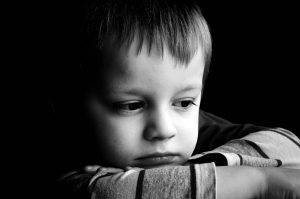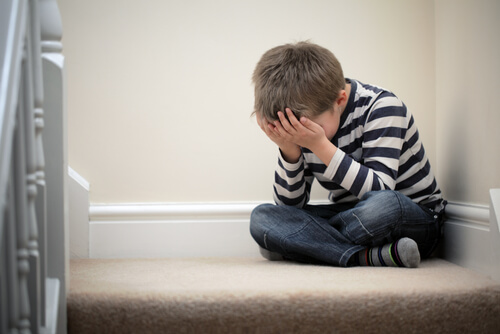Characteristics of Children with Disorganized Attachment

Unfortunately, there is a high percentage of children that suffer or have suffered mistreatment or abuse.
Trauma and stress are chronic derivatives of these situations and lead to serious complications.
Continued exposure to abuse and mistreatment leads children to a dysfunctional conduct known as disorganized attachment.
What is disorganized attachment? Its main characteristic is a chronic and intense fear that causes children to avoid connecting with parents or caregivers.
In fact, children with disorganized attachment will resist remaining in their caregiver’s presence. When forced to spend time with these people, the children experience confusion and bewilderment.
Disorganized attachment – just as the term indicates – is the consequence of very intense traumatic experiences that “disorganize” a child’s social development and make him vulnerable.

In other words, disorganized attachment – also known as disoriented attachment – is a set of symptoms of emotional unease.
Characteristics of children with disorganized attachment
Children with disorganized attachment have difficulty when it comes to controlling their emotions. They also have a hard time relating with others, including children of the same age.
Below is a more detailed list of symptoms of disorganized attachment:
- Children with this type of attachment pattern display conflicting behavior most of the time. For example, the child may seek physical contact and then immediately reject it.
- They express themselves in a disordered way and are redundant in speaking about a single topic.
- These children may display anxiety when they separate from their parents.
- They have a tendency to move in an uncoordinated way and, when afraid, may become completely paralyzed or petrified.
- Children with disorganized attachment have a great susceptibility in regards to their father figure. There may even be marked physical expressions of this susceptibility.
- They’re easily taken aback and display vague speech.
- These children have a tendency to feel like their personal space is being invaded.
- They suffer from post traumatic stress.
- Children with disorganized attachment develop disassociative disorders as well as memory and attention disorders.
- These individuals don’t possess an interest in exploring their surroundings. Rather, they are overwhelmed by uncertainty. Fear paralyzes them when it comes to having new experiences.
- These children usually develop various fears and even phobias.
- They’re constantly in a state of hyper-vigilance. This is because they feel the need to always be on alert, ready to flee from any aggression.
Disorganized attachment and the mother figure
Erroneous emotions
Children who suffer from disorganized attachment display contradictions. For example, they may run towards their mothers to ask for a hug, and then immediately push her away.
Children become desperate in these situations because they don’t really know what it is they want. As a result, they become very uneasy when someone asks them what they want.
Disorientation
- When a child with disorganized attachment feels confusion or is afraid of his mother’s behavior.
- The child seems disoriented in everything he does. In other words, the child is unable to coordinate his actions.
- The disorientation occurs when the mother makes fun of the child or makes him uncomfortable.
These children tend to be very unstable. Therefore, it’s important to be patient and treat them with care and respect.
Shyness or reservation in children
The mother creates considerable emotional distance between herself and the child. This is a trademark characteristic in children with disorganized attachment.
Because the mother feels incompetent, she chooses to keep her distance. For example, she may develop the habit of always greeting her child from a distance, rather than approaching him.
Random and inconsistent behavior
Children who suffer from disorganized attachment can be extremely shy. In fact, they may wish to go completely unnoticed by the rest of the world. At the same time, they may be prone to fits of rage.
It’s important to remember that these behaviors are random and often don’t fit with their circumstance. They don’t know how to get affection and this leads them to express themselves in diverse ways.

Self-stimulation
The seeking of self-stimulation is common among children with disorganized attachment. This may include hitting themselves or banging their heads.
What is the explanation behind this type of self-injury? Unconsciously, they seek to relieve their psychological pain with these actions.
Over time, they may create their own defense mechanisms. They’re experts in hiding painful memories and allow only positive memories of their caregivers to emerge.
In most cases, these caregivers are greatly idealized.
They don’t turn to their parents
These children don’t turn to their parents when they face some sort of problem because they don’t feel comfortable.
This may bring them to cry in secret or wander around aimlessly, far from their parents, their problems and themselves.
These children need professional help in order to develop healthy relationships with their parents or caregivers, whatever the case may be.
All cited sources were thoroughly reviewed by our team to ensure their quality, reliability, currency, and validity. The bibliography of this article was considered reliable and of academic or scientific accuracy.
- Bowlby, J. (1986). Vínculos afectivos: formación, desarrollo y pérdida. Madrid: Morata.
- Bowlby, J. (1995). Teoría del apego. Lebovici, Weil-HalpernF.
- Causera, I. P., & Peris, M. R. (2015). Tras las huellas borderline: Rastreando el apego de personas con trastorno límite de personalidad. Revista REDES, (32), 59-70. https://redesdigital.com/index.php/redes/article/view/179/136
- Comín, M. A. (2012). El vínculo de apego y sus consecuencias para el psiquismo humano. Intercambios, papeles de psicoanàlisis/Intercanvis, papers de psicoanàlisi, (29), 7-17. https://raco.cat/index.php/Intercanvis/article/view/353994/445879
- Garrido-Rojas, L. (2006). Apego, emoción y regulación emocional. Implicaciones para la salud. Revista latinoamericana de psicología, 38(3), 493-507. https://www.redalyc.org/pdf/805/80538304.pdf
- Lecannelier, F., Ascanio, L., Flores, F., & Hoffmann, M. (2011). Apego & psicopatología: Una revisión actualizada sobre los modelos etiológicos parentales del apego desorganizado. Terapia psicológica, 29(1), 107-116. https://scielo.conicyt.cl/scielo.php?pid=S0718-48082011000100011&script=sci_arttext&tlng=en
- Marrone, M., Diamond, N., Juri, L., & Bleichmar, H. (2001). La teoría del apego: un enfoque actual. Madrid: Psimática.
- Moneta, M. (2003). El Apego. Aspectos clínicos y psicobiológicos de la díada madre-hijo. Santiago: Cuatro Vientos.
- Olaso Sainz, M. D. C. (2020). El apego desorganizado y su relación con diferentes patologías infantiles. https://repositorio.comillas.edu/xmlui/bitstream/handle/11531/41341/TFG%20Olaso%20Sainz%2c%20Carmen.pdf?sequence=1&isAllowed=y
This text is provided for informational purposes only and does not replace consultation with a professional. If in doubt, consult your specialist.








